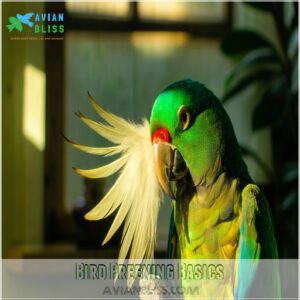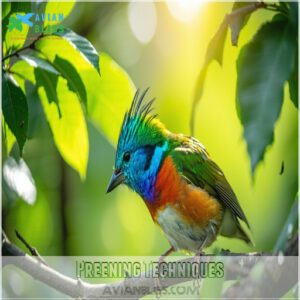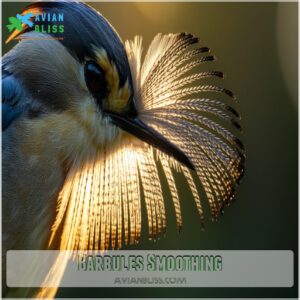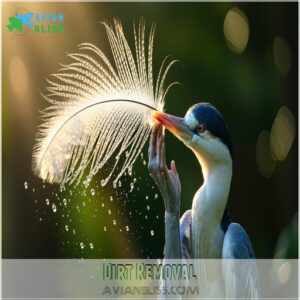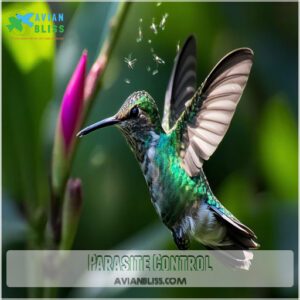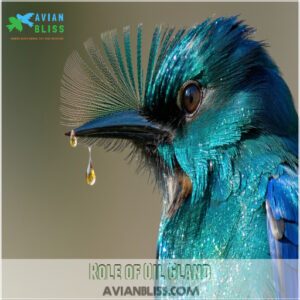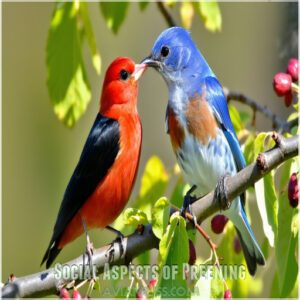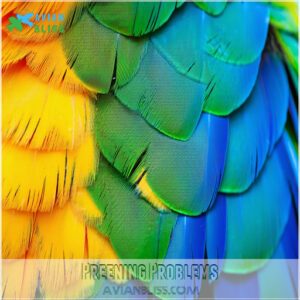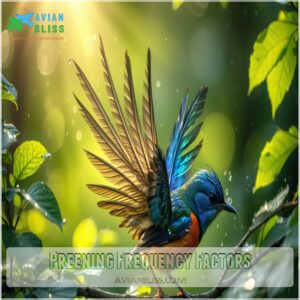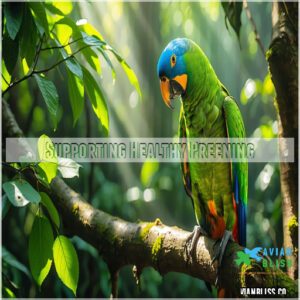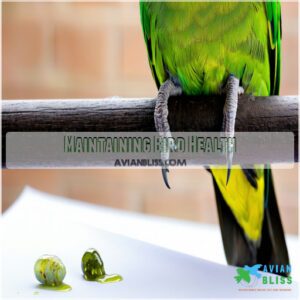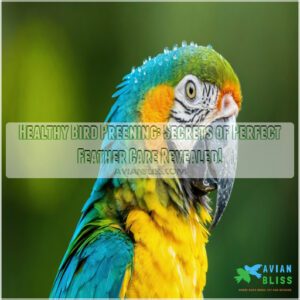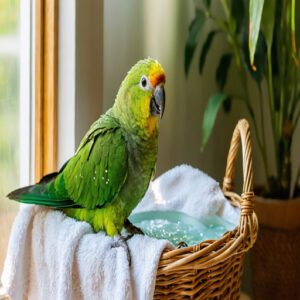This site is supported by our readers. We may earn a commission, at no cost to you, if you purchase through links.

Birds use their beaks to grip each feather at the base, sliding toward the tip to smooth tiny structures called barbules.
They start by fluffing and shaking to loosen dirt and parasites, then diligently clean each feather.
Many birds also apply oil from their uropygial gland near the tail, which keeps feathers waterproof and flexible.
Proper preening maintains body temperature, flight ability, and overall health.
It’s nature’s perfect grooming routine!
Want to understand how birds handle parasites and why preening is so social?
There’s plenty more to explore.
Table Of Contents
- Key Takeaways
- Bird Preening Basics
- How to Preen Bird Feathers
- Preening Techniques
- Feather Structure Maintenance
- Role of Oil Gland
- Social Aspects of Preening
- Preening Problems
- Preening Frequency Factors
- Supporting Healthy Preening
- Maintaining Bird Health
- Frequently Asked Questions (FAQs)
- How do I preen my bird’s feathers?
- What happens if you don’t preen your bird?
- Should you help preen your bird?
- How do birds preen in harsh weather?
- What tools can humans safely use to help preen?
- Can damaged feathers fully recover through preening?
- How does captivity affect preening behavior in birds?
- What are signs of stress-related over-preening?
- Conclusion
Key Takeaways
- Support your bird’s natural preening by providing a clean environment, a balanced diet, and enrichment activities to maintain feather health.
- Watch for over-preening or under-preening as signs of stress, illness, or parasites, and address them promptly to keep feathers in good condition.
- Help your bird gently with hard-to-reach areas like the head or neck, using your fingers or safe, soft tools, but let them handle most of the preening.
- Preening is vital for waterproofing, insulation, and flight, so make sure your bird stays healthy and stress-free to keep their natural grooming routine intact.
Bird Preening Basics
You’ll find that preening is your bird’s natural way of keeping its feathers clean, aligned, and waterproof using its beak and special oil gland.
When you understand the basics of preening, you can help your feathered friend maintain healthy plumage by supporting this essential grooming behavior.
Feather Maintenance
During daily feather maintenance, your bird needs proper preening techniques to keep its plumage in top shape.
Birds use healthy preening techniques for feather hygiene and health.
The preening process starts with your bird using its beak to clean each feather, removing dirt and debris.
For healthy bird feathers, they’ll grip near the base and slide their beak along the length, realigning each strand, which helps maintain their aerodynamic efficiency and insulation properties.
Oil Gland Maintenance
Your bird’s uropygial gland, located near the tail base, needs regular care to keep those feathers in top shape.
Think of it as your bird’s personal oil factory! This preen gland produces specialized oils that your feathered friend uses during preening.
You’ll want to check that the gland isn’t blocked or swollen. When working properly, it releases preen oil that helps maintain those beautiful, healthy feathers, which is essential for your bird’s overall well-being and healthy feathers.
Importance of Preening
Beyond keeping your bird looking sharp, preening is essential for feather health and survival.
Through this natural grooming process, birds maintain waterproof plumage, regulate body temperature, and maintain effective flight ability.
The preening process also removes harmful parasites and strengthens social bonds between flock members.
When birds skip their feather maintenance routine, they risk harming their health, mobility, and essential survival functions.
How to Preen Bird Feathers
Mastering the art of preening bird feathers requires understanding the delicate balance between grooming and natural behavior. When you’re caring for your feathered friend’s plumage, it’s essential to follow their natural preening patterns.
Birds use healthy preening techniques for feather maintenance. Here’s what you need to know about proper feather care and bird hygiene:
- Keep grooming sessions short and gentle to avoid stressing your bird
- Watch for signs that indicate your bird wants help, like presenting their head or neck
- Use clean, sanitized preening tools designed specifically for avian care
- Monitor beak health, as it’s their primary preening instrument
- Respect your bird’s boundaries and stop if they show discomfort
For wing maintenance, gently assist with hard-to-reach areas using appropriate preening tools. Remember that birds know their feathers best – your role is to support their natural grooming instincts while ensuring proper bird feather care. Focus on building trust and maintaining a consistent routine.
Preening Techniques
You’ll need four basic steps to keep your bird’s feathers in top condition: puffing, cleaning, oiling, and realigning.
Your bird’s health depends on proper preening technique, which starts with gently fluffing the feathers and using the beak to clean each section thoroughly.
Puff and Shake
The puff and shake method kicks off your bird’s preening routine with a feather-loosening dance.
You’ll notice your feathered friend ruffling their plumage, creating a puffy appearance that helps dislodge dust and debris.
This shake technique is like their morning stretch – it relaxes feathers and prepares them for detailed grooming.
Watch as they shake vigorously, sending tiny particles flying before moving on to more thorough maintenance.
Clean With Beak
Your beak serves as nature’s perfect preening tool for cleaning feathers.
Start at the base of each feather, gently grip with your bird’s beak, and slide upward to remove feather dust and debris.
Watch as your bird uses precise bill wiping movements to smooth each section.
Don’t rush this beak cleaning process – proper feather smoothing requires patience and attention to detail.
Oil Feather Application
Three key steps guarantee proper oil feather application during preening. Your bird’s uropygial gland produces sebum, a natural preen oil that’s essential for feather health.
Here’s how to help your bird distribute this protective coating:
- Watch for gentle nibbling near the tail’s base
- Observe the careful spreading of oil from neck to wings
- Notice the methodical application to chest feathers
- Monitor coverage of tail feathers, ensuring a complete and thorough application for optimal feather health.
Realign Feathers
After spreading oil through the feathers, it’s time to perfect their alignment.
Hold your bird gently while they stretch their wings – this natural movement helps realign displaced feathers.
Watch as they use their beak to smooth each feather, fixing barbules that may have separated, working methodically, like a master tailor mending precious fabric.
You’ll see them working until every feather sits perfectly in place, a result of their meticulous effort to realign and smooth their feathers, making them look like precious fabric.
Feather Structure Maintenance
Feather structure maintenance is all about keeping barbules smooth, removing dirt, and controlling parasites for healthy, functional plumage.
By ensuring each feather is clean and aligned, you help maintain a bird’s ability to fly, stay warm, and stay protected.
Barbules Smoothing
After cleaning feathers with their beaks, birds focus on maintaining feather alignment by smoothing feather barbules.
Picture it like zipping up a jacket—this precision keeps feathers streamlined for flight.
Using preening tools like their beaks, birds glide along feather barbs to interlock broken segments, improving structure.
Proper barbule care allows feathers to function efficiently for insulation, waterproofing, and brilliant plumage.
- Key points:
- Enhances aerodynamic function.
- Maintains feather flexibility.
- Critical for effective feather maintenance.
Dirt Removal
To keep feathers in peak condition, focus on dirt extraction.
Birds use their beaks as preening tools, gliding along feathers to carefully remove debris.
This feather cleaning step clears dust and grime while maintaining feather health. Remember, preen feathers gently for effective debris removal.
A clean bird feather provides better insulation, flight, and overall feather maintenance for long-term survival.
Parasite Control
Parasites like feather mites, lice, fleas, and ticks can damage your bird’s feathers and health.
Preening helps birds remove these pests naturally. Encourage proper preening behavior by ensuring a clean environment and balanced diet.
For persistent infestations, consider effective bird mite treatment.
Monitor for signs of parasites, like excessive scratching or damaged feathers, and consider parasite treatments if needed.
Maintaining bird health requires vigilant mite removal, lice control, and flea prevention.
Role of Oil Gland
The oil gland, located at the base of a bird’s tail, plays an essential role in keeping feathers healthy.
By producing a special oil, it helps birds waterproof their plumage, prevent brittleness, and maintain flexibility for flight and insulation, which is crucial for their overall well-being and ability to fly.
Oil Production
The uropygial gland, located at the base of a bird’s tail, plays a crucial role in feather maintenance.
This oil gland secretes preen oil, a waxy substance vital for oil gland health.
Birds collect this oil and apply it during preening, which coats their feathers protectively.
The gland’s function sustains steady preen oil production, aiding in maintaining feather flexibility and strength.
Waterproofing Feathers
Birds rely on their preen gland for creating a water-repellent coating, ensuring feathers stay dry and functional.
With oil application from this gland, preening spreads the protective preen wax.
Here’s how waterproofing works:
- Preen wax seals feather barbs, keeping them aligned.
- Feather coating blocks water penetration.
- Water repellent oils enhance insulation during wet weather.
Feather sealing is essential for survival!
Preventing Feather Brittleness
Feathers need flexibility to stay healthy, and that’s where oil application comes in.
By spreading oil from the uropygial gland during preening, birds keep their feathers strong and supple.
Brittle feathers can’t provide proper insulation or flight.
For best feather maintenance, prioritize preening techniques that realign barbs and apply natural oils evenly, ensuring long-lasting feather care and overall feather health.
Social Aspects of Preening
Preening isn’t just about keeping feathers clean—it also plays a key role in building connections between birds.
Through mutual grooming, known as allopreening, birds strengthen social bonds and help maintain harmony in flocks or pairs.
Mutual Preening
Mutual preening isn’t just about feather care; it’s a tender way birds nurture social bonds.
This avian preening behavior, often seen in mated pairs, involves mate grooming to access tricky spots.
These preening rituals strengthen pair bonding, showing bird affection and teamwork. By sharing grooming duties, birds reflect a unique connection, blending hygiene with meaningful bird grooming moments, which is a display of bird affection.
Allopreening
Allopreening, or social preening, isn’t just about cleaning—it’s a key part of social bonding among birds.
By engaging in mutual grooming, birds strengthen relationships, reduce tension, and support flock dynamics.
Whether it’s between mates or flock members, this touch serves to clean hard-to-reach spots and fosters trust and connection, showcasing the intricate preening behavior of bird communities.
Social Bonding
Grooming isn’t just for cleanliness—it’s a bonding behavior too.
Social preening, like mutual grooming or allopreening, strengthens relationships by building trust and maintaining social bonds.
These social rituals, often seen in mated pairs, deepen pair bonding and reduce tensions.
By helping birds clean hard-to-reach spots, mutual preening enhances group harmony, making it a key element of their connected, harmonious lives, which is based on social bonds.
Preening Problems
Preening problems like over-preening or under-preening can signal health or environmental issues in your bird.
Understanding these challenges helps you address potential causes, from stress to parasites, and keep their feathers in top shape, which is crucial for their overall well-being.
Over-Preening
Over-preening happens when feather care turns obsessive.
It can lead to feather damage and stress, often caused by anxiety, diet issues, or irritation.
Watch for overpreening signs like bald patches or excessive grooming.
- Causes: Preening disorders from mites, skin irritation, or boredom.
- Impact: Feather plucking and brittleness.
- Solutions: Provide foraging toys, improve diet, and make sure proper humidity.
Under-Preening
If your bird isn’t preening enough, it could face feather neglect and preening deficits.
Under-preening leads to dry feathers, feather damage, and insulation loss, harming overall feather health.
Proper preening techniques are essential for maintaining healthy plumage and preventing issues like feather damage and loss of insulation.
This issue may stem from illness, stress, or discomfort, and encouraging proper preening techniques through environmental enrichment and monitoring can help.
Regular grooming strengthens feather maintenance, preventing long-term preening issues and keeping your bird healthy.
Medical Factors
Medical factors like feather infections, beak disorders, and skin conditions can disrupt healthy preening, leading to plumage issues.
These problems often cause discomfort, leaving birds over-preening or neglecting feather care. Proper bird preening habits are essential for feather health.
- Mite infestations irritate skin, triggering preening issues.
- Poor diet leads to feather disorders and dull plumage.
- Bird infections like dermatitis increase irritation, affecting bird health.
Monitor signs early to address concerns!
Preening Frequency Factors
How often a bird preens depends on its species, age, and surroundings. Understanding these factors helps you make sure your bird’s feathers stay clean, healthy, and functional.
Species Variation
Feather care isn’t one-size-fits-all.
Species variation shapes preening styles, influenced by bird size, beak shape, and feather color.
Birds use preening to maintain healthy feathers for flight and thermoregulation.
For instance, parrots use their feet, while herons rely on a serrated claw.
Social birds like albatrosses practice mutual preening, contrasting solo preening in hummingbirds.
You can learn more about essential preening behaviors.
| Bird Species | Unique Tool Used | Behavior Type |
|---|---|---|
| Parrots | Feet for hard-to-reach | Solo Preening |
| Herons | Serrated claw (pectinate) | Solo Preening |
| Albatrosses | Beak for mutual cleaning | Mutual Preening |
Age Factors
Younger birds, like fledglings, often struggle with juvenile preening since they’re still learning proper techniques.
As birds age, senior feathers may show wear, and preening frequency can decrease.
Age-related changes affect feather care, requiring careful monitoring for underpreening signs, and maturity stages impact preening styles.
Making species variation in behavior and preening techniques an important consideration for providing effective fledgling care and support.
Environmental Factors
Climate plays a big role in a bird’s preening habits.
Environmental influences like humidity and air quality can affect feather health.
Here are three impacts:
- Pollution impacts feathers by forcing more preening to remove contaminants.
- Humidity effects help maintain feather pliability but low levels cause brittleness.
- Temperature control affects waterproofing after dust baths or bathing options.
Supporting Healthy Preening
You can help support your bird’s natural preening habits by providing the right diet, mental stimulation, and a clean environment.
These factors maintain their feathers stay in top condition, promoting their overall health and well-being.
Balanced Diet
A balanced bird diet supports preening by improving feather quality and overall bird health.
You can find specialized bird food for healthy feathers. Focus on nutrient intake with food variety like seeds, fruits, and vegetables.
Meal planning makes sure dietary needs are met, avoiding deficiencies. Omega-3s and supplements can help maintain vibrant plumage.
| Food Type | Example | Benefit |
|---|---|---|
| Seeds/Nuts | Sunflower Seeds | Energy, Omega-3s |
| Fruits | Berries | Vitamins, Antioxidants |
| Vegetables | Leafy Greens | Minerals, Fiber |
Enrichment Activities
To support healthy preening, integrate bird enrichment activities like foraging toys and sensory play.
Toys rotation keeps them engaged, while grooming aids encourage feather care.
Foraging activities mimic natural behaviors, promoting mental stimulation.
Environmental enrichment, such as perches and varied textures, supports active grooming routines.
Social interaction with other birds also fosters natural preening habits and overall wellbeing.
Positive Reinforcement
Positive reinforcement can encourage healthy preening by shaping your bird’s behavior in a fun, engaging way.
Try these tips:
- Use Reward Training with treats to reinforce preening techniques.
- Introduce Clicker Methods to signal desired preening behaviors.
- Employ Target Sticks to guide your bird toward grooming aids.
- Use Treat Dispensers during grooming to build social bonding and trust.
Maintaining Bird Health
To keep your bird healthy, focus on regular grooming and watching for any changes in their feathers or behavior.
This helps you catch issues like infections or parasites early, ensuring their plumage stays in top condition, with a focus on regular grooming.
Regular Grooming
A regular grooming routine keeps your bird’s plumage healthy and clean.
Make sure their beak is strong enough for preening techniques, as it’s their main grooming tool.
Bird owners can find essential bird grooming supplies online.
Make sure daily feather care by providing safe grooming tools like mist sprays.
This preening guide supports feather maintenance, helping maintain plumage health and ensuring clean bird feathers in an effective daily routine.
Monitoring Health
Keep an eye on your bird’s feather condition by frequent Feather Inspection and Health Checks.
Check for irregularities like damaged feathers, dullness, or signs of over-preening.
Healthy feathers indicate solid Bird Hygiene and overall bird health.
Identifying preening issues early helps maintain bird feather health. Remember, preening benefits your bird’s survival by ensuring proper feather function.
Stay vigilant for excellent care, and prioritize preening for the well-being of your bird.
Preventing Infections
Preventing infections starts with effective preening techniques.
Prioritize feather sanitizing by encouraging proper oil application and beak cleaning routines. Antibacterial methods, like uropygial gland oil, help fight feather problems caused by bird parasites.
Stay vigilant for signs of irritation or damage during feather maintenance. Quick action ensures bird health while maintaining parasite control, promoting strong, resilient plumage.
Prevention is always key to ensuring the overall health of birds, and by following these methods, you can help prevent infections and maintain strong, resilient plumage.
Frequently Asked Questions (FAQs)
How do I preen my bird’s feathers?
Gently support your bird, letting it feel secure.
Use a damp cloth or mist to clean feathers, avoiding the stress of direct grooming.
Birds naturally preen themselves, so focus on providing an enriching, clean environment.
What happens if you don’t preen your bird?
Neglected preening leaves your bird’s feathers like an untended garden—dirty, brittle, and misaligned.
Feathers lose waterproofing, insulation, and flight ability, opening the door to parasites, infections, and discomfort that can hurt your bird’s health and happiness.
Should you help preen your bird?
You can assist your bird by lightly grooming areas it can’t reach, like its head or neck.
Use your fingers gently, mimicking natural preening.
This strengthens trust and social bonding while maintaining feather health.
How do birds preen in harsh weather?
Imagine wearing a raincoat in a storm.
Birds spread oil from their uropygial gland to waterproof feathers, ruffle for insulation, and align barbs for warmth.
Their feathers act like perfectly customized weather armor.
What tools can humans safely use to help preen?
You can safely use a soft-bristled toothbrush or damp cloth to help preen, especially on small, delicate feathers.
Make sure tools are clean, use gentle strokes, and avoid applying pressure to prevent damaging the bird’s feathers, ensuring a safe and effective preening process with gentle care.
Can damaged feathers fully recover through preening?
Damaged feathers can’t fully recover through preening since birds can’t repair broken feather shafts or lost barbs.
Preening helps maintain existing feathers’ condition, but full regrowth only occurs during molting, when new feathers replace the damaged ones.
How does captivity affect preening behavior in birds?
In captivity, a bird’s preening shifts, balancing instinct and environment.
Stress, boredom, and poor conditions can trigger over-preening or neglect.
Providing enrichment, proper diet, and socialization helps mimic natural habits, supporting healthy feather maintenance and behavior.
What are signs of stress-related over-preening?
Over-preening from stress shows with excessive feather damage, bald spots, broken or chewed feathers, and compulsive grooming.
Birds may seem restless or anxious, over-focus on certain areas, or even neglect socializing or other natural behaviors, exhibiting compulsive grooming and signs of excessive feather damage.
Conclusion
Think of preening bird feathers as nature’s way of crafting perfection.
By keeping feathers clean, aligned, and oiled, birds maintain they stay healthy, fly efficiently, and maintain waterproof protection.
Understanding how to preen bird feathers helps you support their natural grooming, whether through proper diet, enrichment, or monitoring for issues like over-preening.
Preening isn’t just a beauty ritual; it’s critical for their survival.
With care and attention, you can foster your feathered friend thrives!
- https://blog.mybirdbuddy.com/post/bird-clean-feathers
- https://en.wikipedia.org/wiki/Preening
- https://birdfact.com/bird-behavior/bathing-and-preening/preening-behaviors
- https://journeynorth.org/hummingbirds/featured/maintaining-flight-feathers-preening
- https://centerofthewest.org/2023/07/10/whats-that-bird-doing-preening-rousing/

